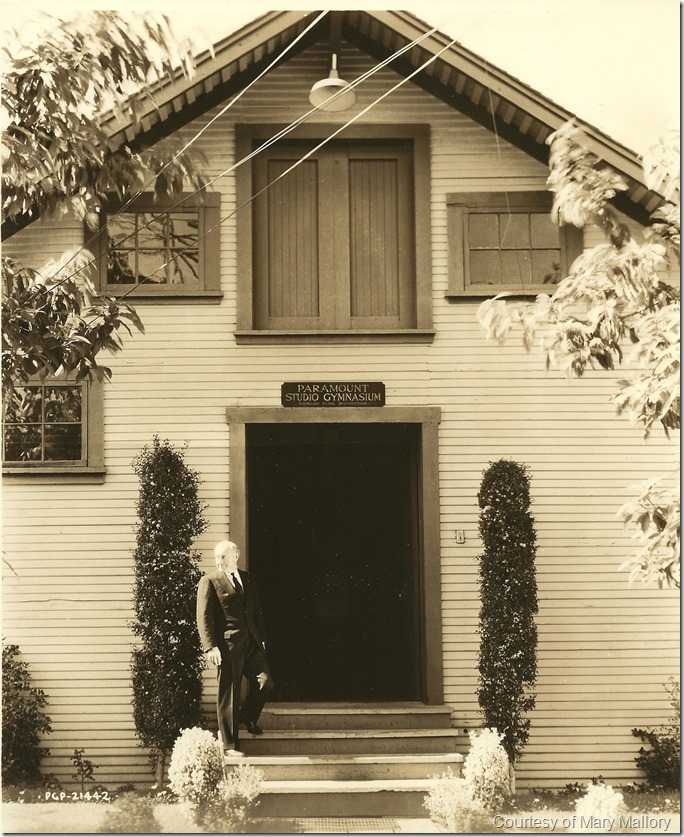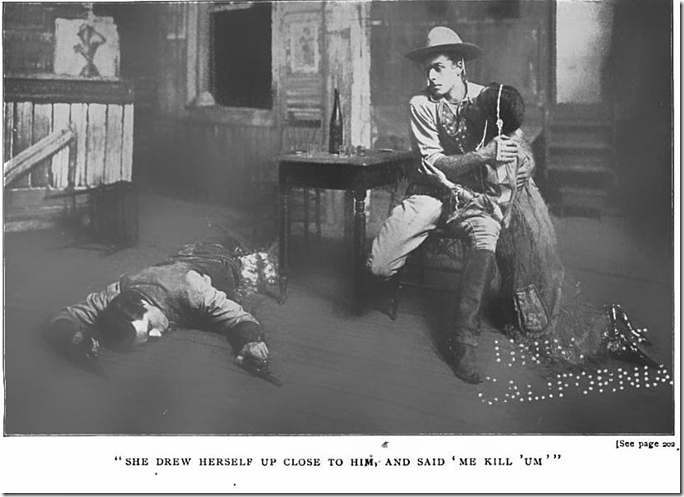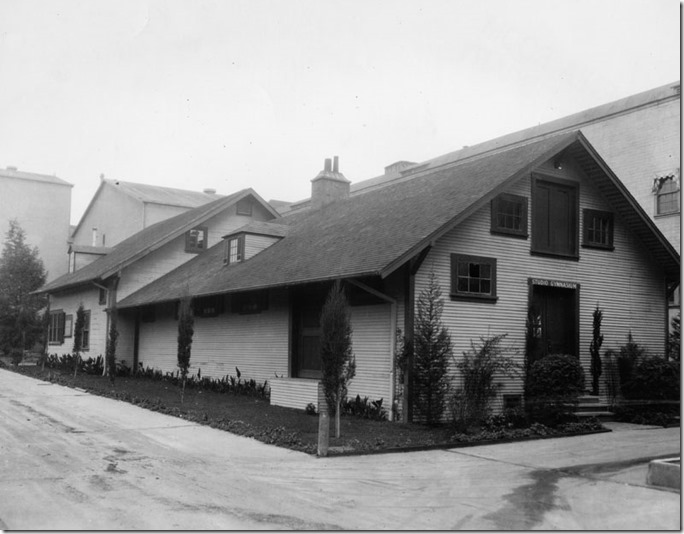
Cecil B. DeMille on the steps of the barn, which Paramount was using it as a gym, photo courtesy of Mary Mallory.
Most visitors to the Hollywood Bowl probably don’t realize the historic significance of the little gray barn sitting across Highland Avenue in Parking Lot D. Cecil B. DeMille directed his first feature film, “The Squaw Man,” outside this tiny structure a century ago, making it the West Coast birthplace of what is now Paramount Pictures. Countless stars have walked through its doors over the years, and the building has appeared in many films and television shows. For more than 112 years, this small barn has witnessed the evolution of Hollywood from sleepy village to filmmaking capital.
In 1901, businessman and investor Robert Northam erected a grand mansion costing $10,000 at the southwest corner of Prospect Avenue and Vine Street for his young bride, Leotia. Across the street and south of Selma Avenue, the tycoon constructed a homely barn to board horses and farming equipment. Northam sold the property in 1904 to real estate developer Jacob Stern, who employed the stable as a garage for his large touring car, one of the first in Hollywood. Within a few years, a new industry would spring up around the Stern property.
Note: To highlight the Lasky-DeMille barn and “The Squaw Man” centennial, the Hollywood Chamber of Commerce is hosting a celebration Tuesday, July 1 from 5 p.m. to 8 p.m. in the parking lot outside the Hollywood Heritage Museum, featuring beer and wine, ice cream photo stations, vintage cars, face painters, games, horses and a fire engine. Tickets cost $10. Parking is available entering from Odin Street. Marc Wanamaker and Mary Mallory will be giving a presentation in the barn on the building and filmmakers’ history.

The barn in an undated photo, courtesy of Archive.org.
Escaping wintry weather and patent company detectives, film companies began descending on the small burg of Hollywood in 1909. Renting taverns and other commercial establishments, filmmakers began churning out moving pictures. Astute local businessmen L. L. Burns and Harry Revier leased the barn at 6284 Selma Ave. from Stern in late 1912, offering it as a potential rental lot for aspiring filmmakers.
Actor/director Cecil B. DeMille arrived in Los Angeles Dec. 20, 1913, eager to start shooting Edwin Milton Royle’s western saga “The Squaw Man,” on behalf of the Jesse Lasky Feature Play Co. Subleasing the barn from Burns and Revier for $250 a month, DeMille and his co-director Oscar Apfel began shooting on Dec. 29, 1913. DeMille bought the Burns and Revier interests in March 1914. Revier went on to direct films for various companies while Burns purchased a costume firm, renaming it Western Costume Co.

“The Squaw Man” is available at Archive.org.
Upon its release in February 1914, “The Squaw Man,” earned over $250,000, firmly establishing Lasky and DeMille as successful filmmakers.
The executives continued producing films on stages behind the little barn, with DeMille establishing an office inside the facility. Merging with Adolph Zukor’s Famous Players to form Famous Players-Lasky in 1916, the filmmakers bought the property outright from Stern that year to construct an actual film studio around the original structure. Over the next several years, DeMille and Lasky constructed a topnotch production facility on nine acres stretching from Selma Avenue to Sunset Boulevard, with the simple barn now merely a storage shed.

A still from “The Squaw Man,” published in the novel.
By 1926, the company outgrew their lot, and began searching for a new location on which to expand their facilities. They settled on 26 acres north of Melrose Avenue, acquiring land from the Hollywood Cemetery and United Studios to construct a state-of-the-art film studio with ample room to grow, under the new corporate name, Paramount Pictures. The filmmakers earned a huge profit selling the Vine Street lot to investors, retaining ownership of the original barn.
Carefully packed on a horse-drawn truck, the company moved the dusty little barn to the new studio in 1926, the sentimental good luck charm of the new conglomerate. This small relic consecrated the beginning of Hollywood filmmaking, the start of DeMille’s and Lasky’s illustrious careers in film, and the birth of Paramount Pictures. Where once horses rested and produce and grain were stored, Paramount’s stars now flexed muscles, played ping pong, and rowed machines in the studio gym, known as “the gray room.”

A still from “The Squaw Man,” published in the novel.
Over the next several decades, the landmark rested peacefully next to the studio restaurant, functioning as gym, rehearsal hall, meeting room and special event facility for the studio. Men such as Orlando Perry and Jim Davies offered massages and managed the gym. Paramount celebrated “The Squaw Man’s” release in 1936 with a star-filled luncheon held inside the unpretentious building. To honor DeMille’s 30th anniversary in motion pictures, the studio threw a party inside the landmark in 1942. Bob Hope emceed the event, broadcast over NBC Radio and attended by such Paramount stars as Paulette Goddard and Gary Cooper.
The old gray barn also appeared in countless films and television shows, beginning with its first known appearance as a dilapidated barn in the 1914 film “The Only Son.” Exterior shots of the building can be seen in such films as “The Rainmaker,” “Bonanza” television episodes, and other westerns. The interior appears as a gym in “The Devil’s Hairpin” and the 1979 Henry Winkler film, “The One and Only.”

The barn in a photo from the Department of Water and Power archives.
On Dec. 27, 1956, the State of California designated the Lasky-DeMille Barn as California Historic State Landmark No. 554, recognizing the Barn as the first major film studio in Hollywood.
By the late 1970s, however, Paramount required more office space, and most of the western back lot was scheduled for demolition. In 1979, Paramount Studios gave the Lasky-DeMille Barn to the Hollywood Historic Trust, a cultural heritage division of the Hollywood Chamber of Commerce. Dennis Lidtke, then owner of the Palace Theatre on Vine Street, now The Avalon, allowed the group to move it to a parking lot beside the Palace, while they searched for a permanent home.
The barn sat deteriorating in the parking lot for several years, until a newly formed historic preservation organization called Hollywood Heritage jumped into action. Leaders Marion Gibbons, Christy McAvoy, Susan Peterson-St. Francis, Mildred Heredeen, and Frances Offenhauser rallied former Supervisor John Anson Ford and then-current Supervisor Edward Edelman to their cause. Edelman found the structure a home near the Hollywood Bowl, where a movie museum had originally been planned.
In 1983, the building was transported during the late evening so the local news stations could document its’ move to its new location, and after some sprucing up, opened to the public in 1985. Exhibits focused on early Hollywood, early filmmaking, and the history of Paramount. Hollywood Heritage held movie screenings and regular events at the structure until an arson fire in 1996.

The barn serves as a location for “The Devil’s Hairpin,” photo courtesy of Mary Mallory.
After renovation and repair, Hollywood Heritage Museum opened again in 1999. Today the museum features movie props, costume pieces, memorabilia, archival photographs and original posters on display, along with three short films that play continuously.
Hollywood Heritage holds monthly “Evenings @ the Barn” from October through June that focus on film and Hollywood-related history, and present special film screenings both at the Barn and at the Paramount Ranch in the summer.
Along with running the Museum and hosting events, Hollywood Heritage actively works to preserve the historic built environment of Hollywood. Thanks to the work of the group, such Hollywood icons as the El Capitan Theatre, Egyptian Theatre, Jane’s House, and Roosevelt Hotel have been restored and preserved.
While 112 years old, the hardy Lasky-DeMille Barn still gracefully welcomes visitors to bustling Hollywood, a poignant reminder of the simple farming community from whence it sprung.


Great story about Hollywood/ Paramount history. I wonder if Mary Malloy or some of the great historian types that peruse these pages would answer some questions that have always bugged me ?
Which has the oldest Hollywood studio, Paramount or Universal ?
What Hollywood studio is considered to be the first, period ?
What is the oldest Hollywood studio, still functioning as a movie studio ?
Many thx from an East Coaster…. a film buff for 60 years.
LikeLike
Dave,
Universal would be the oldest, it’s been in operation in the Universal City/Forest Lawn area since 1912, Paramount didn’t start until “The Squaw Man” in late December 1913.
The first studio in Hollywood is Nestor in 1911 at Sunset and Gower, but D. W. Griffith and Biograph made a few films here in 1909-1910, and Selig was the first to film in LA (downtown) in 1909.
The oldest Hollywood studio still functioning would be Paramount, since it started at Selma and Vine as the Jesse L. Lasky Feature Play Co. in 1913, before moving to Melrose in 1926 as Paramount.
LikeLike
Mary,
Thx so much for your reply. I’ve enjoyed reading many of your articles.
LikeLike
Mary……………….great job as usual
LikeLike